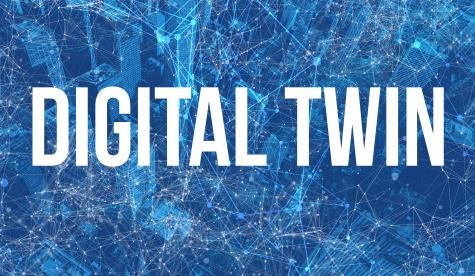Aren’t twins awesome?!!!
Do you know that they start playing with each other
in their mother’s womb?
Some twins even speak their own language.
Not necessarily always identical, they can also be a mirror-image of each other with birthmarks on the opposite sides of their bodies.
Yet, you may not know that twins can be born years apart.
They have different fingerprints.
They can even have different dads.
And you can tell them apart by their belly buttons!
Wouldn’t you like to have a twin?!!
It is not too late. You can have a virtual one, a digital twin.
More importantly, we can even create digital twins
of the complex world around us.
Overview
Digital twins are virtual representations of real-world objects, processes, or systems. They help us recognize and preemptively address future problems to avoid damage or failures. They can also help us redesign products and processes to increase efficiency, effectiveness, and appeal.
According to Grand View Research, the global digital twin market was about USD 11.13 billion in 2022. In the coming year, it is expected to rapidly grow at the CAGR of 37.5%. The US digital twin market is also expected to grow fast at 33.7% CAGR till the year 2030.


Source: Statista
Digital twins are used in various industries, including manufacturing, automotive, aviation, utilities, healthcare, logistics, retail, etc.
This graph, by Statista, shows the industry market sizes for leading industries.
India Story
Coinciding with India’s expected high economic growth in the coming years, the digital twins market is expected to grow at a CAGR of 62.3% to reach USD 76.67 billion by the year 2030, according to Grand View Research.

Image Source: CityZenith
When Indian state of Andhra Pradesh was bifurcated, it needed a new capital city. A brand-new city, called Amaravati, was planned. A Chicago-based company, CityZenith, had developed a digital twin for Amaravati. It enabled interactive simulation of the city blocks under various conditions, including the seasonal cycle.
Indian companies (e.g., Wipro, Paninian, Pratiti, ActualView) assist in setting up digital twins for various sectors: aerospace, healthcare, manufacturing, energy, construction, retail, hospitality, etc. In August 2023, Geospatial World Think Tank released an extensive report on digital twin strategy for Indian infrastructure.
Key challenges in India are access to:
Infrastructure
- Advanced sensor technology
- Highly scalable computing power
- Reliable ubiquitous high-speed network
Skill gap
- Relevant Intellectual property
- Research support
- Skilled workforce
Cost
- Private funding
- Government incentives
- Regulatory support
Data integration
- Big data analytics
- Rapid data processing
- Modeling techniques
Security
- Cybersecurity protections
- Enforcement mechanisms
- Risk allocation and mitigation methods
Underlying Technologies

Image Source: PMF Research
Several technologies that are already available to us come together in Digital Twins. Here are the most important ones.
IoT
IoT-based sensors continuously collect data related to the physical part or process to enable instantaneous replication in its digital twin.
Cloud
Cloud and edge computing technologies supported by network infrastructure allow real-time interactions among the physical and digital twins.
Big Data
Data warehousing and management technologies store cross-sectional and temporal data related to digital twins.
AI/ML
Artificial intelligence and machine learning technologies provide the tools and models to automatically analyze the data, make inferences, provide insights, and offer predictions.
AR/VR/MR
Augmented/Virtual/Mixed Reality technologies provide the visualization of digital twins in various forms, including holography.
Robotics
These technologies, in several situations, help modify the physical part or process to reflect the changes made in the virtual part.
Interesting Use Cases
The Living Heart Project

Image Source: Dassault Systems
Dassault Systems, in collaboration with the US FDA, leading researchers and relevant practitioners, has undertaken the Living Heart Project to revolutionize cardiovascular science by realistic modeling of human heart. The project aims to help in education and training, medical device design, testing, clinical diagnosis and regulatory science.
Product Design – Volvo

Image Source: 3DS and Volvo
In the development of its SuperTruck line (ST1), Volvo used digital twin to assess aerodynamic flow of various product design options. The purpose was to improve freight efficiency and minimize greenhouse gas emission in diesel-powered trucks. It helped Volvo achieve an 88% improvement over its previously most efficient truck VNL 670.
Smart Cities

Image Source: ASME
Geo-digital twins can simulate and analyze behavioral patterns within a building, subdivision, and even entire city.
- Effect of the movement of people and vehicles.
- Energy consumption fluctuations and carbon footprint under various environmental conditions.
- Water resources needs and waste management.
- Impact of different types of natural disasters.
Telecom Network

Image Source: FNT
A digital twin can help analyze the utilization of a cellular network under various conditions, such as customer demographics, population density, expected population growth, environment conditions, and the layout of the terrain. Use these insights to determine the number and locations of cellular towers and equipment power required.
Who Would Be Interested?

Image Source: Elsevier
Aerospace
- Aircraft design and defect detection.
- Aerodynamic performance under various conditions.
- Airport designs – The flow of people in terminals; the movements of aircrafts and airport vehicles on jet bridges, taxiways, and apron areas.
Construction and Real Estate
- Complex structural designs.
- Space capacity utilization.
- Construction simulations for project planning and control.
- Assessments of the performance of a building.
- Visualization of various interior and exterior design options.
- Virtual tours of properties.
Automotive
- The designs of vehicles – Assess performance under various designs.
- Designing driver assistance systems to operate under various conditions.
- Predictive maintenance of individual vehicles in a fleet of vehicles.
- Determining locations and usages of the electric vehicle charging network.
Retail
- Customer experience enhancement.
- Superstore design for smoother foot-traffic flow.
Manufacturing
- Shop floor design.
- Material flow simulations.
- Operations traceability.
- Predictive maintenance needs.
Logistics
- Delivery network simulation for routing and dynamic rerouting.
- Fleet management and maintenance.
- Integrated optimization of driver and fuel costs.
Utilities
- Simulating patterns in electricity usage and their impact on the grid.
- Conducting predictive circuit breaker operations to avoid blackouts and brownouts.
- Transmission tower design and infrastructure deployment.
- Disaster response simulations.
Healthcare
- Telehealth assistance.
- Simulated testing of trial drugs.
- Disease diagnostics and assessing therapy responses.
- Training for surgical procedures.
Education
- Immersive student engagement.
- Skill training related to physical objects.
- Personalize learning experiences.
Agriculture
- Crop decisions in massive farms.
- Soil conditions management and enhancements.
- Land mapping and title management,
- Testing alternate farming techniques, such as vertical farms.
Mining
- Visualization of deep shaft mines.
- Design the efficient movements of ore and miners.
- Mining hazard management.
Strategic Considerations
Infrastructure
Digital twins require well-planned, high-performance infrastructure to gather useful data and work effectively with it. Legacy infrastructure may pose challenges in integrating new technologies leading to risks and uncertainties.
Economies of scale
Digital twins require significant upfront capital investments. So, it may favor larger companies, which have resources to invest and undertake initial losses. Smaller firms may need help, perhaps through government incentives, to curtail their falling behind and exacerbating a digital divide.
Data quality and quantity
For digital twins to function effectively, they require a flow of quality data continuously and in large quantities. So, in many cases, process reengineering would be needed to embed IoT devices to enable the data availability. This becomes particularly significant in mission-critical, integrated systems, where data is drawn from multiple and disparate sources.
Connectivity
Power outages, network downtime, software bugs, or ongoing deployment errors can impact the connectivity among IoT devices. So, redundancy in energy supply, network and servers would be needed to reduce the impact.
Ongoing maintenance and upgrade
Software updates, real-life changes to the physical asset, enhancements to the digital twin, etc. would mean ongoing management and maintenance. Related costs, time and resources must be factored into the planning, pricing, and contracting for digital twins and the total life cycle cost of every digital twin.
Legal and Tax Considerations
IoT Rules and Regulations
Internet of Things (IoT) are integral parts of digital twin systems. So, the regulatory and legal regimes applicable to IoT would also apply to digital twins, including those around data, privacy, security, trust, and infrastructure.
Data Privacy and Data Protection
Data privacy and data protection issues emerge from the collection of data, especially of personal data involving people, by digital twins of processes and systems. Such personal data collection would require the consent of the people. There should also be clear protocols regarding the accuracy of personal data.
In addition, the usage of data in the digital twin must be authorized by the data owner. And the usage should be as intended by the owner.
Digital twins may also represent proprietary products and processes. So, there are cybersecurity risks involving sensitive business data. Moreover, digital twins are also vulnerable to cyberattacks on the infrastructure or systems they replicate.
Cybersecurity laws need to be modified to address the impact not only on the computer network and data of digitals twins, but also on the associated physical infrastructure and systems they represent.
Moreover, there is a possibility of a digital twin being used for malicious purposes, especially when it is made public. Ransomware or other anti-social attacks can cause maximal damage both the digital twins and underlying product, process, or system.
Standardized modelling
Presently, there is no standardized approach to modelling for digital twins. This may raise challenges for interoperability between digital twins.
Intellectual Property Rights
Intellectual property rights are also important considerations with digital twins given they involve multitudes of technologies for various sources. While building and operating digital twins, proper care must be taken to avoid the infringement of the IP rights of third parties.
When IP rights are licensed from third parties, additional complex issues may arise. For example, whether the intellectual property rights are being used as intended, or who owns the new works created in development of digital twins and other related matters. All involved parties should consider and clearly establish at the outset who will own what parts of a digital twin through intellectual property rights or otherwise.
Currently, there are no standardized approaches to the modelling of digital twins. As standards get developed, some of them may be proprietary and would require licensing.
Incentives
Innovative technologies like digital twins are complex and expensive. In an effort to encourage businesses, especially small business who are without the financial wherewithal to undertake financially intensive projects such as creation and adoption of digital twin technology, to adopt innovative technologies, governments often offer tax incentives and grants.
They can help offset the costs of implementation and speed up research and development.
- R&D Incentives: Tax credits, deductions or exemptions for R&D expenses relating to the development and implementation of digital twins could be a possible avenue.
- Sustainability Incentives: Digital twins can contribute to sustainable practices and digital transformation, qualifying businesses for additional tax incentives or grants that are focused on promoting such objectives.
- Cross-border and Regional Grants: Certain grant programs, primarily funded by international organizations, may require collaboration between businesses in different countries. Such grants can provide valuable resources for implementing digital twin technology.
Transfer pricing
Digital twin technology can impact value chain and intangible assets within an organization, but across the borders, potentially creating transfer pricing issues. It can also lead to creation and enhancement of intangible assets, including software or proprietary processes.
This may impact allocation of profits between related entities in different jurisdictions. As such, organizations may require licensing or cost-sharing arrangements to be put in place.
The profit allocation to the digital twin intangible assets will typically be a key driver for the overall tax incentives the organization may be able to claim in different jurisdictions.
Socio-Ethical Considerations
Assurance, governance, and trust
A digital twin is often perceived as a black box. So, internal control and audit procedures need to be set up to assure that it is performing as expected. In addition, training and governance mechanisms are needed to build trust.
Capturing complex, dynamic environment
Representing complex dynamical environment, such as weather, human behavior, or ecosystems, in a digital twin requires huge amount of continuous data. The size of such data and processing power required to process them can overwhelm the system. So, appropriate sampling and statistical methods would be needed, which in turn can reduce the accuracy and lead to errors, misrepresentation, discrimination, and wrong decisions in some cases.
Liability/ Allocation of Risk
In case of wrongful predictions by digital twins, preemptively decide who bears the responsibility for the losses suffered. Such risks and liabilities increase exponentially when multiple systems are integrated into one digital twin.
Regulation of humanity
Digital twins, especially in the context of smart factories, housing communities and cities, involve people. Regulation of people as objects may create grave problems, both real and perceived. Ethical challenges are further intensified due to feedback effects, side effects or cascading effects of using digital twins. One such example is the “lock-in effects” caused by outdated technological or operational rules. In such cases, digital twins may promote control-oriented closed societies rather than opportunity-creating free societies.
Usage patterns and discrimination
Usage patterns of people, specifically how they occupy space, act, interact and move around, are very complex. They may even differ among people with different socio-economic status and medical conditions. An infrastructural digital twin may not have adequately anticipated such patterns. The resulting infrastructure may allow certain people to do certain things, while restricting others, specifically with respect to ownership, access, and agency. This leads to hurtful competition, conflict, inequality, and injustice.
Click here to listen to the five-part Podcast of this issue from your favorite podcast directory.
Click here to view the five-part Videos of this issue from your favorite video channel.
Sources and Further Reading
- Digital Twin Technology. EITC. 2023.
- Digital twins improve real-life manufacturing. MIT Technology Review, 5 Jan 2022.
- What is digital-twin technology? McKinsey & Co. 12 Jul 2023.
- Digital Twin Market Size, Share & Trends Analysis Report. Grand View Research. 2022.
- Global digital twin market size by industry. Statista. Jan 2020.
- Forecast 2023 – How Digital Twin technology will evolve in 2023. IndiaAI. 21 Dec 2022.
- Exploring the Future of Digital Twin Technology in India: Opportunities and Challenges. MediaWire. 30 Jun 2023.
- A Digital Twin for Amaravati. CityZenith, 6 Jun 2019.
- Digital Twin: Benefits, use cases, challenges and opportunities. Decision Analytics Journal. Mar 2023.
- Unleashing the Potential of Digital Twins in Education - A Revolution in Learning. Christopher Turner, 3 Mar 2023.
- How AI digital twins help weather the world’s supply chain nightmare. MIT Technology Review, 26 Oct 2021.
- Digital Twins: Potentials, Ethical Issues, and Limitations. Working paper by Helbing and Sánchez-Vaquerizo. 2022.
- Digital Twin: Enabling Technologies, Challenges and Open Research. IEEE Access. 28 May 2020.
- What are digital twins and what are the legal issues with them? Lexology. 8 Jul 2021.
- Understanding Digital Twins and their implementation in manufacturing. PWC. 2023.
- Digital Twins: Legal Consideration. Clifford Chance. 23 Feb 2023.
- Emerging technologies: Internet of Things and Digital Twins. ACMA. Mar 2021.






 i
i


